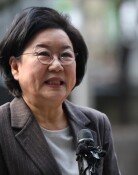Weakening Investments Threaten Growth
Weakening Investments Threaten Growth
Posted December. 27, 2005 03:02,
President A of a renowned Korean conglomerate has many worries these days. Although his company posted a net profit of 100 billion won this year, he is unsure if such strong earnings will continue over the five to 10 years to come, considering the companys business structure.
Moreover, he finds it hard to locate new investment targets to bet the companys future on. Since failed investments entail great responsibilities and new investments may take years to bear fruit, it is difficult to push ahead to make new investments. Even if new investments are decided upon, there remain obstacles as foreign investors, who account for 45 percent of the total shareholders, are sure to protest regarding uncertainty in profitability.
In the end, president A decided to use a quarter of his companys earnings to repay debts and to pay cash dividends to shareholders. The rest will be held in the company as retained earnings.
President As decision demonstrates why investments, the engine of future growth, are quickly diminishing.
New facility investments with long-term perspective are crucial for Koreas economy to make a leap forward, but in reality, things are going in the opposite direction.
According to the Ministry of Finance and Economy and Bank of Koreas announcement made yesterday, Koreas annual real economic growth rate was 4.5 percent for nine years from 1996, a year after the nations per capita income surpassed $10,000, to 2004. In the meantime, however, facility investments grew by a mere 0.5 percent.
On the contrary, advanced nations annualized facility investment growth was higher than economic growth during the period when their per capita income rose from $10,000 to $20,000. For instance, facility investments increased on average by 4.8 percent in the U.S., 4.5 percent in the U.K., 8.8 percent in Japan and 10.8 percent in Singapore.
Koreas facility investments compared to GDP is continuing to decline below 10 percent after falling to 9.6 percent in 2003, 9.2 percent in 2004 and 9.0 percent this year through September.
Although facility investments compared to GDP was 14.1 percent in 1995 and 1996, and plunged to 8.4 percent in 1998 after the financial crisis, it soon recovered to record more than 10 percent from 1999 to 2002.
When companies dont make facility investments, their products can lose competitiveness and the number of new employees can be reduced, thereby undermining the growth potential of the economy as a whole.
There are concerns that if more companies choose to focus on cutting costs rather than on increasing sales by making new investments, jobless growth is likely to persist in the economy.
It is worrisome that Korean firms seem to see little merit in making domestic investments. The government must introduce aggressive deregulation to boost domestic investment and attract foreign investment by improving the investment environment in Free Economic Zones, says Professor Chang Se-jin of Korea University.
Do-Young Kim nirvana1@donga.com legman@donga.com



![화장실 갇혔을 때 생존법…“최후에는 변기뚜껑” [알쓸톡]](https://dimg.donga.com/c/138/175/90/1/wps/NEWS/IMAGE/2025/12/26/133042007.3.png)



